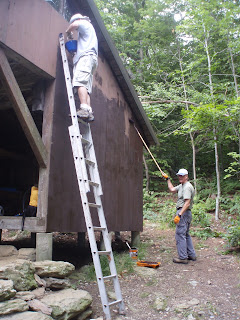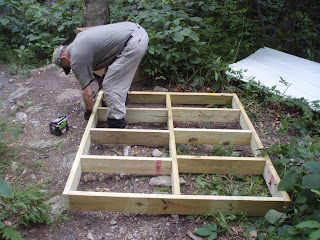July 10, Crystal Mountain Campsite gets a Bear Box (and picnic table)
In our ongoing effort to help AT visitors reduce their impact on wildlife, we have been installing food storage boxes at one or two campsites each season (see June 25th post).Today, it was Crystal Mountain Campsite. Good timing, since two weeks ago Ridge Runner Dennis came across a mother bear and two cubs feeding on blackberries on the nearby powerline.
Crystal Mountain (where there are no crystals and its elevation barely rises above the rest of the ridge line) has the distinction of being the overnight site that is furthest from a road in Massachusetts, and it is solidly up hill from every direction. It is our most primitive site. Prior to this visit, it only offered a few flat tentsites, a privy and a nearby stream.
Rather than tote a 90lb steel box the full 4.5 miles up from Dalton or Cheshire, we chose to access the site via a power line that crosses the AT about .25 miles to the south. The hike up the power line is a steep one-mile slog, pretty much straight up. Existing ATV/maintenance twin track provided an excellent opportunity to use the AT Committee's power wheelbarrow. This small, tracked transporter can be heavily loaded and will traverse rough terrain with relatively little impact. It is slow and does require careful maneuvering to prevent the load from tipping sideways. On this trip it carried about 200lbs and replaced the equivalent of six 9 mile round trips had we hand-carried the gear.
Here, Don and Adam start up the power line with a tall load.
Routes through steep sections were scouted in advance, running the power wheelbarrow across the slope will result in it tipping over.
Keeping feet clear of the rubber tread is important.
A clear, sparkling day made for great views as we climbed above the valley.
It took an hour and a half to cover the one mile climb to the AT. With 5 on the crew, it took less than 30 minutes to ferry all the parts the short distance to the campsite. Because the AT is narrow and travels over a wide field of rocks between the power line and campsite, it was not possible to use the wheelbarrow beyond the power line.
We also chose to carry a picnic table to install at the campsite as well. The addition of the table and bear box to this primitive campsite was not taken lightly. They will forever alter the experience at this location. What was once just a few worn flat areas in the middle of the woods now has some of the conveniences of our regular shelter sites. We hope that the bear box will encourage hikers to properly store their food without damaging the trees in the area and the picnic table will help concentrate food prep and eating to a central location, rather than near tenting areas.
















